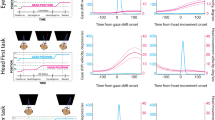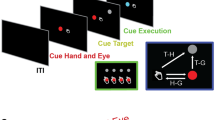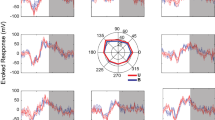Abstract
The ventral premotor area (PMv) is a major source of input to the primary motor cortex (M1). To examine the potential hierarchical processing between these motor areas, we recorded the activity of PMv neurons in a monkey trained to perform wrist movements in different directions with the wrist in three different postures. The task dissociated three major variables of wrist movement: muscle activity, direction of joint movement and direction of movement in space. Many PMv neurons were directionally tuned. Nearly all of these neurons (61/65, 94%) were 'extrinsic-like'; they seemed to encode the direction of movement in space independent of forearm posture. These results are strikingly different from results from M1 of the same animal, and suggest that intracortical processing between PMv and M1 may contribute to a sensorimotor transformation between extrinsic and intrinsic coordinate frames.
This is a preview of subscription content, access via your institution
Access options
Subscribe to this journal
Receive 12 print issues and online access
$209.00 per year
only $17.42 per issue
Buy this article
- Purchase on Springer Link
- Instant access to full article PDF
Prices may be subject to local taxes which are calculated during checkout






Similar content being viewed by others
References
Alexander, G. E. & Crutcher, M. D. Preparation for movement: neural representations of intended direction in three motor areas of the monkey. J. Neurophysiol. 64, 133–150 (1990).
Kalaska, J. F. & Crammond, D. J. Cerebral cortical mechanisms of reaching movements. Science 255, 1517–1523 (1992).
Soechting, J. F. & Flanders, M. Moving in three-dimensional space: frames of reference, vectors and coordinate systems. Annu. Rev. Neurosci. 15, 167–191 (1992).
Kakei, S., Hoffman D. S. & Strick, P. L. Muscle and movement representations in the primary motor cortex. Science 285, 2136–2139 (1999).
Matsumura, M. & Kubota, K. Cortical projection of hand-arm motor area from post-arcuate area in macaque monkey: a histological study of retrograde transport of horseradish peroxidase. Neurosci. Lett. 11, 241–246 (1979).
Muakkassa, K. F. & Strick, P. L. Frontal lobe inputs to primate motor cortex: evidence for four somatotopically organized premotor areas. Brain Res. 177, 176–182 (1979).
Dum, R. P. & Strick, P. L. in Motor Control: Concepts and Issues (eds Humphrey, D.R. & Freund, H.-J.) 383–397 (John Wiley and Sons, New York, 1991).
Kurata, K. Corticocortical inputs to the dorsal and ventral aspects of the premotor cortex of macaque monkeys. Neurosci. Res. 12, 263–280 (1991).
Matelli, M., Camarda, R., Glickstein, M. & Rizzolatti, G. Afferent and efferent projections of the inferior area 6 in the macaque monkey. J. Comp. Neurol. 251, 281–298 (1986).
Lu, M.-T., Preston, J. B. & Strick, P. L. Interconnections between the prefrontal cortex and the premotor areas in the frontal lobe. J. Comp. Neurol. 341, 375–392 (1994).
Kubota, K. & Hamada, I. Visual tracking and neuron activity in the post-arcuate area in monkeys. J. Physiol. (Paris) 74, 297–312 (1978).
Rizzolatti, G., Scandolara, C., Matelli, M. & Gentilucci, M. Afferent properties of periarcuate neurons in macaque monkeys. I. Somatosensory responses. Behav. Brain Res. 2, 125–146 (1981).
Rizzolatti, G., Scandolara, C., Matelli, M. & Gentilucci, M. Afferent properties of periarcuate neurons in macaque monkeys. II. Visual responses. Behav. Brain Res. 2, 147–163 (1981).
Fogassi, L. et al. Coding of peripersonal space in inferior premotor cortex (area F4). J. Neurophysiol. 76, 141–157 (1996).
Graziano, M. S. A., Hu, X. T. & Gross, C. G. Visuospatial properties of ventral premotor cortex. J. Neurophysiol. 77, 2268–2292 (1997).
Godschalk, M., Lemon, R. N., Nijs, H. G. T. & Kuypers, H. G. J. M. Behaviour of neurons in monkey peri-arcuate and precentral cortex before and during visually guided arm and hand movements. Exp. Brain Res. 44, 113–116 (1981).
Gentilucci, M. et al. Functional organization of inferior area 6 in the macaque monkey. I. Somatotopy and the control of proximal movements. Exp. Brain Res. 71, 475–490 (1988).
Boussaoud, D. & Wise, S. P. Primate frontal cortex: effects of stimulus and movement. Exp. Brain Res. 95, 28–40 (1993).
Kurata, K. Premotor cortex of monkeys: set- and movement-related activity reflecting amplitude and direction of wrist movements. J. Neurophysiol. 69, 187–200 (1993).
Moll, L. & Kuypers, H. G. J. M. Premotor cortical ablation in monkeys: contralateral changes in visually guided reaching behavior. Science 198, 317–319 (1977).
Shen, L. & Alexander, G. E. Neural correlates of a spatial sensory-to-motor transformation in primary motor cortex. J. Neurophysiol. 77, 1171–1194 (1997).
Rizzolatti, G. et al. Functional organization of inferior area 6 in the macaque monkey. II. Area F5 and the control of distal movements. Exp. Brain Res. 71, 491–507 (1988).
Rizzolatti, G., Luppino, G. & Matelli, M. The organization of the cortical motor system: new concepts. Electroenceph. Clin. Neurophysiol. 106, 283–296 (1998).
Fogassi, L. et al. Cortical mechanism for the visual guidance of hand grasping movements in the monkey. A reversible inactivation study. Brain 124, 571–586 (2001).
Gallese, V., Fadiga, L., Fogassi, L. & Rizzolatti, G. Action recognition in the premotor cortex. Brain 119, 593–609 (1996).
Luppino, G., Murata, A., Govoni, P. & Matelli, M. Largely segregated parietofrontal connections linking rostral intraparietal cortex (areas AIP and VIP) and the ventral premotor cortex (areas F5 and F4). Exp. Brain Res. 128, 181–187 (1999).
Murata, A. et al. Object representation in the ventral premotor cortex (area F5) of the monkey. J. Neurophysiol. 78, 2226–2230 (1997).
Wessberg, J. et al. Real-time prediction of hand trajectory by ensembles of cortical neurons in primates. Nature 408, 361–365 (2000).
Hoffman, D. S. & Strick, P. L. Step-tracking movements of the wrist in humans. I. Kinematic analysis. J. Neurosci. 6, 3309–3318 (1986).
Weinrich, M. & Wise, S. P. The premotor cortex of the monkey. J. Neurosci. 2, 1329–1345 (1982).
Kurata, K. & Tanji, J. Premotor cortex neurons in macaques: activity before distal and proximal forelimb movements. J. Neurosci. 6, 403–411 (1986).
Kurata, K. Distribution of neurons with set- and movement-related activity before hand and foot movements in the premotor cortex of rhesus monkeys. Exp. Brain Res. 77, 245–256 (1989).
Hoffman, D. S. & Strick, P. L. Step-tracking movements of the wrist. IV. Muscle activity associated with movements in different directions. J. Neurophysiol. 81, 319–333 (1999).
Crammond, D. J. & Kalaska, J. F. Differential relation of discharge in primary motor cortex and premotor cortex to movements versus actively maintained postures during a reaching task. Exp. Brain Res. 108, 45–61 (1996).
Schwartz, A. B., Kettner, R. E. & Georgopoulos, A. P. Primate motor cortex and free arm movements to visual targets in three-dimensional space. I. Relations between single cell discharge and direction of movement. J. Neurosci. 8, 2913–2927 (1988).
Acknowledgements
We thank A.P. Georgopoulos, J.F. Kalaska, S.I. Helms-Tillery and L.E. Sergio for help with the statistical analysis. We thank E. Stappenbeck for care and training of the animal, K. Hughes and M. O'Malley-Davis for technical assistance, and M. Page and W. Hartz for computer program development. This work was supported by funds from the Department of Veterans Affairs, Medical Research Service and Rehabilitation Research and Development Service (P. L. Strick).
Author information
Authors and Affiliations
Corresponding author
Rights and permissions
About this article
Cite this article
Kakei, S., Hoffman, D. & Strick, P. Direction of action is represented in the ventral premotor cortex. Nat Neurosci 4, 1020–1025 (2001). https://doi.org/10.1038/nn726
Received:
Accepted:
Published:
Issue Date:
DOI: https://doi.org/10.1038/nn726
This article is cited by
-
Modulating Cortical Hemodynamic Activity in Parkinson’s Disease Using Focal Transcranial Direct Current Stimulation: A Pilot Functional Near-infrared Spectroscopy Study
Brain Topography (2023)
-
Zoomorphism
Erkenntnis (2021)
-
Shared functional connectivity between the dorso-medial and dorso-ventral streams in macaques
Scientific Reports (2020)
-
Individual movement features during prism adaptation correlate with after-effects and interlimb transfer
Psychological Research (2020)
-
Neural Evidence of the Cerebellum as a State Predictor
The Cerebellum (2019)



